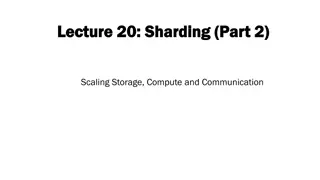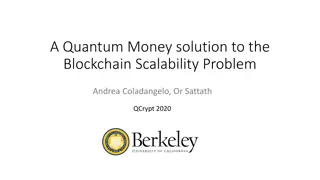
Security Issues in Ethereum Blockchain and Solidity
Explore the various security challenges and vulnerabilities in Ethereum's blockchain and Solidity smart contracts, including DoS attacks, front-running, and unexpected contract behaviors. Learn why updating blockchain protocols and smart contracts is not always a straightforward solution. Stay informed to protect your assets and transactions in the digital realm.
Download Presentation

Please find below an Image/Link to download the presentation.
The content on the website is provided AS IS for your information and personal use only. It may not be sold, licensed, or shared on other websites without obtaining consent from the author. If you encounter any issues during the download, it is possible that the publisher has removed the file from their server.
You are allowed to download the files provided on this website for personal or commercial use, subject to the condition that they are used lawfully. All files are the property of their respective owners.
The content on the website is provided AS IS for your information and personal use only. It may not be sold, licensed, or shared on other websites without obtaining consent from the author.
E N D
Presentation Transcript
Blockchain Security Analysis With a focus on Ethereum s Blockchain along with Solidity
Why are there security Issues? Blockchain Can they just update? Time frame Voting (EIP - Ethereum Improvement Protocol) Disclosure Case - Ethereum Unannounced Hard Fork Solidity Can they just update? Solidity Versions Updating smart contracts Not easily
DoS Attack Vulnerabilities Can I packet flood a blockchain?
DoS Attack Vulnerabilities There are several DoS Attacks that Ethereum has. Front-Running DoS with (Unexpected) revert Gas Limit DoS on a Contract via Unbounded Operations Gas Limit DoS on the Network via Block Stuffing Insufficient gas griefing Does this affect any other blockchains? Most DoS attacks take advantage of cost variance Miners/Validators Predictable (Nodes may choose the highest transaction fee paid)
Front-Running Displacement Sends a similar transaction with a higher gas price Same command - higher gas Ex.) Buying a domain with crypto Insertion A person can many transactions that alter the state This may change the outcome of a person who sent a transaction earlier. Suppression AKA. Block stuffing Typical DoS attack - send a lot of high fee transaction to prevent others to use. Used to suppress other transactions.
DoS with (Unexpected) revert Can lock up a smart contract Takes advantage of the revert and require keywords Ex.) Ebay
Gas Limit DoS on a Contract via Unbounded Operations Takes advantage of looping over items that have a While statement that could be long. Can be unintentional or intentional. If the contract locks or only allows one call at a time, it will deny others. Call 98 gwei -> Function(x) cost 100 gwei Loop forever
Gas Limit DoS on the Network via Block Stuffing Attacker sends transactions that fill up the block s gas limit and causes other transactions to be delayed. Takes advantage of Block gas limit Ethereum has a gas limit of 12,500,000 gwei A Ethereum transfer = ~21,000 gwei A Decentralized exchange such as Uniswap can be >100,000 gwei
Gas Limit DoS on the Network via Block Stuffing Ex Fomo3D-Block-Stuffing-Attack Block stuffing attack on a gambling website https://etherscan.io/address/0xb97d8e30128ae7bf7ebe62bc019f521b8d276d42
Insufficient gas griefing Attacker calls a top level call with enough gas. A inner call will fail since the attacker sent enough for it to fail. Since it passed the outer function, it consumes a lot of gas. This can be used to also lock a smart contract since it can keep failing in the inner call.
Reentrancy on a Single Function In this attack, an attacker will use a malicious smart contract to call a single function in the victim smart contract. When the victim contract does a call.value , it will call the fallback function in the malicious smart contract and call the function again.
Cross-function Reentrancy Extremely similar to the Single Function Reentrancy The fallback function is called in the malicious smart contract, but calls a completely different function. Why? Set a variable Function order control
Cross-function Reentrancy Cases DAO attack (Fallback attack) coindesk, hackingdistributed
Now it is Sids time to talk about some other security vulnerabilities in both Solidity and the Blockchain!






















